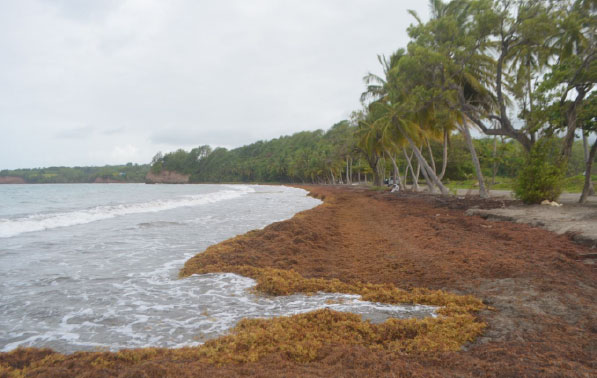What to do with all that sargassum? Marine scientists explore options

Sargassum, a type of brown macroalgae that looks to the layperson like seaweed, has been washing up on Gulf Coast and Caribbean beaches in such higher volume in the past decade that entire research studies, symposiums and more have been mandated to discuss the mysteries surrounding its increased presence.
From October 23-26, the French island archipelago of Guadeloupe hosted Sarg’Expo 2019, the world’s first international conference on sargassum. Hundreds of preeminent marine biologists, representatives from various Caribbean countries, researchers and academics from across the globe, members of the United Nations and high-ranking politicians were present, including the French Prime Minister Édouard Philippe.
Representatives from Texas A&M University at Galveston attended the inaugural symposium and A&M-Galveston faculty are involved in three funded projects in collaboration with the French government.
Karl Kaiser, associate professor in the Department of Marine Sciences, is heading up one such study, specifically involving the identity and origins of sargassum.
Kaiser said the first objective of the Sargassum ORIGINS project is to clearly identify the sargassum species growing in the North Atlantic, with a particular focus on the species involved in inundations. The second objective is to study the connectivity of sargassum at the Atlantic scale, with a focus on the fluxes and exchanges that are occurring between the Sargasso Sea and the new area of proliferation. The role of the rivers (Amazonian and African) in the proliferation of the sargassum is regularly argued, thus a third objective is to learn the origin of the different nutrients that contribute to the ocean currents sargassum is drawn from and to.
One of the most major and prevalent issues is huge, stinking masses of sargassum rotting in the summer sun on popular beaches. It’s a sore sight many who have traveled to Galveston in past years have become accustomed to.
Marine Sciences Professor Emeritus Tom Linton, who helped bale sargassum into hay bale-style collections and use as natural dune-building supports, has studied the impact of sargassum on Gulf Coast beaches for decades and also supervised a program that developed the predictive model for forecasting in advance (by up to as much as two weeks) the arrival of sargassum on beaches in the Gulf of Mexico and the Caribbean Sea.
“We came away with the clear understanding that what our session, and the conference in general, brought into sharp focus was the need for better communication and collaboration. The best means of achieving them is to start with the adoption of SargNet (Sargassum Inventory Database – operated by Florida International University) as our primary means of those goals,” Linton said.
David Hala, assistant professor in the Department of Marine Biology, is another A&M-Galveston researcher whose work has a major impact on the study and mitigation of sargassum.
“As sargassum strandings are increasing in prevalence, there is concern for the pollution of coastal ecosystems. Environmentally relevant concentrations of these pollutants will be tested in this project, making our results highly relevant for understanding adverse effects on aquatic ecosystems,” Hala said of his collaborative project that aims to study the effects of commonly occurring marine pollutants on fish health.
Diego L. Gil‐Agudelo, director of research operations, said there are so many mitigating circumstances involving sargassum that it truly will take all of the world’s leading scientists and thought leaders to solve this issue.
“There’s lots of questions and many of those are regarding the impact of flora and fauna. Sea turtles feed on sargassum and many fish species lay eggs in and then grow as part of a mass of sargassum,” he explained. “It’s affected by winds, inflows, currents and more. So many different stakeholders have feelings about this issue from a tourism and marine biology standpoint.”

